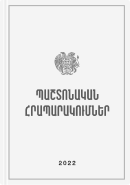Ընդունված է Ազգային ժողովի կողմից 2020 թվականի հունիսի 22-ին
ՀԱՅԱՍՏԱՆԻ ՀԱՆՐԱՊԵՏՈՒԹՅԱՆ ՍԱՀՄԱՆԱԴՐՈՒԹՅԱՆ ՓՈՓՈԽՈՒԹՅՈՒՆՆԵՐ
Հոդված 1. 1995 թվականի հուլիսի 5-ի Հայաստանի Հանրապետության Սահմանադրության` 2015 թվականի դեկտեմբերի 6-ի փոփոխություններով, 213-րդ հոդվածը շարադրել հետևյալ խմբագրությամբ.
| «Հոդված 213. | Սահմանադրական դատարանի անդամների (դատավորների) և նախագահի պաշտոնավարումը |
1. Մինչև Սահմանադրության 7-րդ գլխի ուժի մեջ մտնելը նշանակված և Սահմանադրական դատարանի անդամի կամ դատավորի պաշտոնում ընդհանուր տևողությամբ ոչ պակաս, քան 12 տարի պաշտոնավարած Սահմանադրական դատարանի անդամի (դատավորի) լիազորությունների ժամկետը համարվում է ավարտված, և պաշտոնավարումը դադարում է:
2. Մինչև Սահմանադրության 7-րդ գլխի ուժի մեջ մտնելը նշանակված Սահմանադրական դատարանի անդամը, որի պաշտոնավարումը չի դադարում սույն հոդվածի 1-ին մասի ուժով, շարունակում է պաշտոնավարել որպես Սահմանադրական դատարանի դատավոր մինչև այդ պաշտոնում նրա պաշտոնավարման 12 տարին լրանալը` հաշվի առնելով նաև մինչև Սահմանադրության 7-րդ գլխի ուժի մեջ մտնելը, ինչպես նաև Սահմանադրության 7-րդ գլխի ուժի մեջ մտնելուց հետո պաշտոնավարած ժամկետը:
3. Սահմանադրության 7-րդ գլխի ուժի մեջ մտնելուց հետո Սահմանադրական դատարանի դատավորների թափուր տեղերի համար առաջադրումները կատարում են հաջորդաբար Կառավարությունը, Հանրապետության նախագահը և դատավորների ընդհանուր ժողովը: Սույն հոդվածի 1-ին մասի հիմքով առաջացած` Սահմանադրական դատարանի դատավորի թափուր տեղերի համար առաջադրումները կատարվում են թափուր տեղն առաջանալուց հետո` երկամսյա ժամկետում:
4. Սահմանադրական դատարանի նախագահի պաշտոնավարումը դադարում է: Սահմանադրական դատարանի նախագահի պաշտոնը թափուր մնալուց հետո Սահմանադրական դատարանի նախագահն ընտրվում է Սահմանադրության 166-րդ հոդվածով սահմանված կարգով, որն իրականացվում է Սահմանադրական դատարանի դատավորների` սույն հոդվածի 1-ին մասի հիմքով առաջացած թափուր տեղերը համալրելուց հետո:»։
Հոդված 2. Սույն Սահմանադրության փոփոխություններն ուժի մեջ են մտնում պաշտոնական հրապարակմանը հաջորդող օրվանից:



